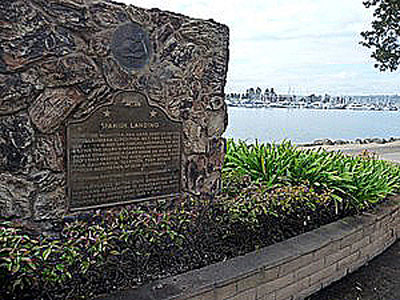By Donald H. Harrison

SAN DIEGO – Screened from the major part of San Diego Bay by the 1.5 mile-long Harbor Island—which was created in 1961 from materials dredged to make San Diego Bay deeper for large naval vessels – Spanish Landing requires a leap of the imagination to appreciate its historic significance.
Approximately at this location in 1769, two ships from La Paz, New Spain, laid at anchor, 60 members of their combined crews of 159 persons sick from scurvy. The ships had been sent up the California coastline on the orders of Jose de Galvez, who had come from Spain as the visitor-general, a direct representative of King Carlos III.
Worried that Russian settlement in Alaska could lead to a challenge of the claim Spain had made to Alta California since Juan Rodriguez Cabrillo’s voyage in 1542, Galvez had dispatched the ships San Carlos under the command of Vicente Vila and San Antonio commanded by Juan Perez as two components of a four-pronged expedition. Their orders were to begin the colonization of a territory whose residents were Native Americans known in San Diego as the Kumeyaay.
The other two arms of the expedition were overland parties – one led by Fernando de Rivera y Moncada, who was a captain attached to the Presidio in Loreto and accompanied by the Franciscan priest Juan Crespi. The second party, which left Mission Santa Maria in the interior of Baja California was commanded by Gaspar de Portola, the overall military leader of the expedition, and the Franciscan Padre Junipero Serra, who was its spiritual leader.
The San Carlos departed for Alta California on January 9, 1769 and the San Antonio on February 15. Adverse conditions and unnecessary detours based on the maps of Sebastian Vizcaino of 1602 kept the San Carlos at sea 110 days, compared to only 55 for the San Antonio. Thus the ship that had left second had arrived first. But another ship in the expedition, the supply ship San Jose, did not arrive at all. What became of it is one of California’s first mysteries.
The San Carlos and the San Antonio rendezvoused at San Diego Bay at the end of April, anchoring not at the site of today’s Spanish Landing but possibly a mile to the west. With so many crew members sick, and with the ship’s surgeon, Dr. Don Pedro Prat, unable to counteract the scurvy, San Diego—hot in the daytime, freezing cold at night—offered the patients little comfort. They died at the rate of three or four a day.
Somewhere in the vicinity, the wretched detachment of Spanish soldiers were joined on May 14 and July 1 respectively by the Moncada and Serra overland expeditions. Clifford Graves in the Spring 1976 edition of The Journal of San Diego History pointed out that while overland journeys normally were more dangerous than those by sea, the trekkers all arrived healthy, except for Father Serra, who had an ulcerated leg.
The ships subsequently changed their position in the Bay, anchoring as close to present-day Spanish Landing as the foot of Laurel Street, which runs along the eastern perimeter of Lindbergh Field. The group then moved inland to Presidio Hill, which was high and more defensible than the bayside camp and which also had the advantage of the freshwater San Diego River passing close by. Here survivors needed a month of recuperation.
*
Harrison is editor of San Diego Jewish World. Do you have a San Diego County sightseeing venue to recommend that Don Harrison write about? Please contact him with details at sdheritage@cox.net
